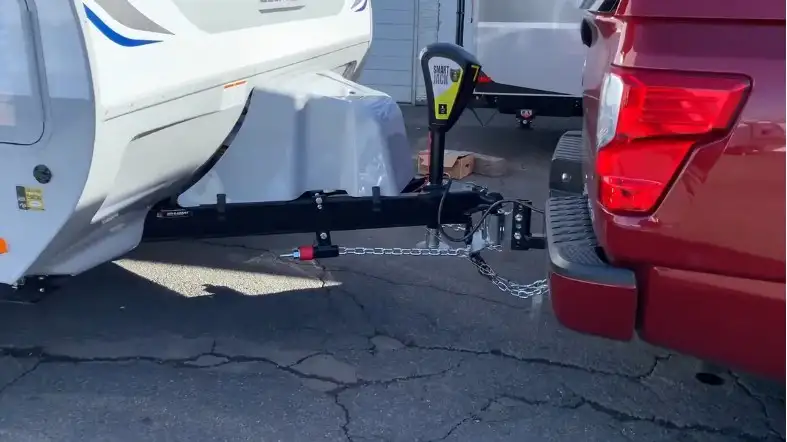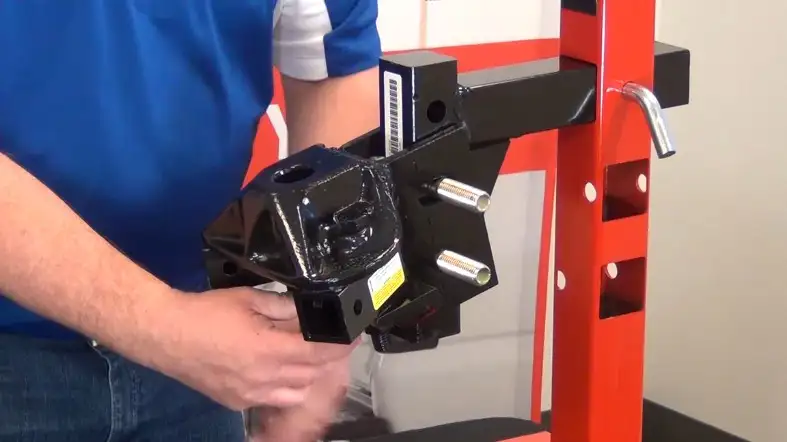Setting up a weight distribution hitch is not as difficult as it may seem. If you have the right tools and instructions, you can easily set one up on your own.
This blog post will show you how to set up a weight distribution hitch step by step.
How To Set Up A Weight Distribution Hitch?
You can set up a weight distribution hitch in four easy steps:

Step 1: Measure Vehicle and Trailer Height
Make sure your trailer is level with the ground by using the tongue jack and a level.
Park your vehicle and trailer on a flat surface before beginning this process.
Before you can set up your weight distribution hitch, you need to measure the height of your vehicle and trailer.
This will ensure that the hitch is properly positioned and leveled. Also, make sure to take into account the height of any cargo you may be carrying.
Step 2: Position Weight Distribution Hitch
Once you have measured the height of your vehicle and trailer, you can now position the weight distribution hitch.
The best way to do this is by using a jack to lift the tongue of your trailer. This will make it easier to position the hitch.
Step 3: Set Weight Distribution Hitch Head Angle

To begin, tilt your head downward and place two washers on the adjustment rod. Insert the rod into the lower hole located on the head.
If your weight distribution hitch is different and doesn’t require this step, then consult the instructions that came with it.
Tilting the head back, rotate it into the mounting position on the shank. It should be vertical or only tilted slightly back.
You may need to add or remove a few washers until you get the proper angle.
Place the second bolt in the top hole of the hitch head and fix both bolts with accompanying nuts and washers. Make the bolts snug but don’t over-tighten them.
Step 4: To connect the trailer to your vehicle, install spring bars
First, mount the spring bars on the hitch head. If the chains are not yet attached to the spring bars, do so now before mounting the bars onto the head.
Hook up the trailer by raising the coupler and aligning it with the trailer ball on the tow vehicle.
Once the coupler is locked onto the ball, lower the trailer tongue until it rests on the ground.
Step 5: Raise the trailer jack and attach the chains
After latching the coupler onto the trailer ball with the trailer jack, lift it up until it’s about three inches above level.
If your trailer is too low or too high, it will put unnecessary stress on the weight distribution hitch.

Now, take the chains and attach them to the chain brackets on the trailer frame.
The hooks should be facing downwards so that they can easily latch onto the brackets. Be careful to not make the chains too loose or too tight.
Step 6: Engage the Hookup Brackets
Using the spring bar chains as a guide, position the brackets that hold the bars onto the trailer frame.
Next, use provided bolts to secure those brackets to the trailer frame. Join the spring bar chains to the brackets.
See to it that both sides are vertically aligned with an equal number of chain links between the spring bars and the hookup brackets.
Use the provided lift handle to pry the brackets into the locked position.
Step 7: Adjust the weight distribution hitch
Now it’s time to adjust the weight distribution hitch.
This will ensure that your trailer is level and the tongue weight is properly distributed.
Loosen the bolts on the adjustment brackets located on either side of the hitch head.
Next, raise or lower the spring bars until the trailer is level. As you have found the right position, tighten the bolts on the adjustment brackets.
Now, measure the distance between the ground and the coupler. This is your tongue weight. It should be between 10-15% of your trailer’s total weight.
If it’s too low or too high, you will need to readjust the spring bars.
Step 8: Check all connections and enjoy the ride
Before you hit the road, it’s important to check all of the hitch’s connections.
This includes bolts, chains, brackets, and couplers. Make sure that everything is tight and secured.
With a properly installed weight distribution hitch, you can tow your trailer with confidence.
Tips for Using a Weight Distribution Hitch
Here are a few tips to help you get the most out of your weight distribution hitch:

- Use anti-seize compound on all bolts and nuts to prevent them from rusting or becoming difficult to remove.
- Periodically check the bolts and chains to make sure they are tight and secure.
- When backing up, be extra careful as the trailer may swing out behind you.
- If you are not using your weight distribution hitch for an extended period of time, it’s a good idea to remove it and store it in a dry, protected area.
- If you are using your weight distribution hitch in inclement weather, make sure to clean and lubricate all moving parts on a regular basis.
- When hitching or unhitching your trailer, always put safety first. Make sure to follow all instructions carefully and never try to do it alone.
When Do You Need a Weight Distribution Hitch?
If you are planning on towing a trailer, then you will need a weight distribution hitch.
This is because the tongue weight of the trailer can cause the tow vehicle to become unstable and increase the risk of an accident.
For safety reasons, it’s important to distribute the tongue weight evenly across the axles of the tow vehicle and trailer.
This can be done with a weight distribution hitch. Even if you are not planning on towing a trailer, you may still need a weight distribution hitch.
This is because the tongue weight of some trailers can cause the tow vehicle to become unstable and increase the risk of an accident.
The hitch will help to keep the trailer from tipping over and will make for a smoother, more stable ride.
So, if you are planning on towing a trailer, make sure to invest in a quality weight distribution hitch.
Types of Weight Distribution Hitches

There are three main types of weight distribution hitches: round bar, trunnion bar, and Andersen.
In the below sections, we will take a closer look at each type of hitch and its key features.
Round Bar Weight Distribution Hitch
The round bar weight distribution hitch is the most common type of hitch on the market.
It is designed to work with trailers that have a tongue weight between 400 and 1,200 pounds.
The hitch consists of a metal frame that mounts onto the trailer’s frame. There are two spring bars that attach to the frame and extend to the hitch head.
The hitch head is mounted on the tow vehicle’s frame and has two adjustment brackets that are used to level the trailer.
The spring bars are connected to the brackets via chains. When properly adjusted, the weight distribution hitch will distribute the tongue weight evenly across the axles of the tow vehicle and trailer.
This will help to keep the trailer from tipping over and will make for a smoother, more stable ride.
Trunnion Bar Weight Distribution Hitch

The trunnion bar weight distribution hitch is designed for use with trailers that have a tongue weight between 10,000 lbs. It is similar to the round bar hitch, but it has a few key differences.
First, the trunnion bar hitch has two arms that extend from the frame to the hitch head.
These arms are connected via a pivot point, which allows them to pivot when the trailer is being turned.
Second, the trunnion bar hitch has two adjustment brackets that are used to level the trailer.
These brackets are connected to the arms via chains. And third, the trunnion bar hitch has a built-in sway control system.
This system helps to keep the trailer from swaying back and forth, which can be a major cause of accidents.
Like the round bar hitch, the trunnion bar hitch will help to keep the trailer from tipping over and will make for a smoother, more stable ride.
Andersen Weight Distribution Hitch

The Andersen weight distribution hitch is a new type of hitch that is quickly gaining in popularity.
It is designed for use with trailers that have a tongue weight of up to 14,000 pounds. The Andersen hitch consists of a metal frame that mounts onto the trailer’s frame.
There are two spring bars that attach to the frame and extend to the hitch head.
The hitch head is mounted on the tow vehicle’s frame and has two adjustment brackets that are used to level the trailer.
The spring bars are connected to the brackets via chains. What sets the Andersen hitch apart from other weight distribution hitches is its unique ball mount design.
The ball mount is designed to pivot when the trailer is being turned, which helps to keep the trailer from swaying.
The Andersen hitch also has a built-in sway control system. This system helps to keep the trailer from swaying back and forth, which can be a major cause of accidents.
Like the other two types of hitches, the Andersen hitch will help to keep the trailer from tipping over and will make for a smoother, more stable ride.
Maintaining your Weight Distribution Hitch
It is important to regularly inspect your weight distribution hitch to make sure that it is in good working condition.
You should check the chains and brackets for wear and tear, and make sure that the hitch head is securely mounted on the tow vehicle’s frame.
If you notice any damage, it is important to have the hitch repaired or replaced as soon as possible.
A damaged hitch can cause the trailer to tip over, which can lead to serious accidents.
When you are not using your weight distribution hitch, it is important to store it in a dry, sheltered place.
This will help to prevent rust and corrosion from damaging the hitch.
If you follow these tips, your weight distribution hitch will last for many years and will help to keep you and your family safe on the road.
FAQs on how to set up a weight distribution hitch
Does A Weight Distribution Hitch Really Work?
Yes, a weight distribution hitch really does work.
It is designed to distribute the tongue weight of the trailer evenly across the axles of the tow vehicle and trailer.
This helps to keep the trailer from tipping over and makes for a smoother, more stable ride.
Do I Need A Weight Distribution Hitch?
If you are planning on towing a trailer, then it is highly recommended that you use a weight distribution hitch.
This type of hitch is especially important if you will be carrying a heavy load.
How Do I Know If My Trailer Is Too Heavy For A Weight Distribution Hitch?
Most weight distribution hitches are designed for trailers with a tongue weight between 1,000 and 14,000 pounds.
If your trailer has a tongue weight that is outside of this range, then you will need to find a hitch that is specifically designed for heavy trailers.
Conclusion
If you are planning on towing a trailer, then it is highly recommended that you use a weight distribution hitch.
Now you have all about setting up weight distribution hitches and how they work, as well as how to maintain them.
So, don’t wait any longer and get yourself a weight distribution hitch today.
